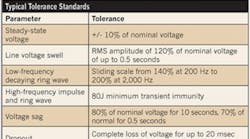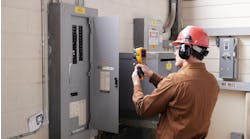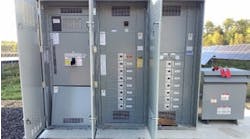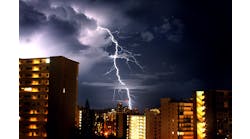Inside Voltage Quality Verification
Lurking in the shadows of even the most unsuspecting operations — from corporate to commercial to industrial facilities — is a condition known as poor voltage quality, a hidden expense that typically goes undetected and undiagnosed until costly failures occur. Voltage events interrupt sensitive processes, shorten the useful life of equipment, and cause computer and communications problems. Oftentimes, these disturbances trigger needless expenses in the form of implemented solutions to misdiagnosed problems. Unless the source of the problem is correctly identified and its cause found and repaired, the costs and time required to solve the problem add up quickly.
Defined in terms of magnitude (amplitude) and duration (length), voltage events — appearing in the form of sags, swells, impulses, and total harmonic distortion — can affect equipment performance in different ways. Typically, the ultimate impact of such events is determined by the sensitivity of the equipment on the branch circuit.
-
Voltage sags
A sag is a period of low voltage. Minor sags occur frequently, sometimes without disturbing equipment performance. Major sags, on the other hand, always disturb equipment performance. Sags occur for many reasons, including voltage drop caused by long runs of wire, switching loads, poor wiring, and overloaded branch circuits.
-
Voltage swells
A swell is a period of high voltage. Swells have serious impact on equipment function; however, they are not as common as sags. Both minor and major swells affect equipment performance.
-
Impulses
An impulse is a short burst of energy that lasts for less than a cycle. Impulses range in magnitude from twice the nominal voltage to several thousand volts. Not every impulse has an impact on equipment performance. However, when impulses occur repeatedly over time (or when the energy level is very high), an impulse can cause equipment degradation or even immediate failure.
-
Harmonics
AC voltage is a sine wave that repeats 60 times per second (Hertz = cycles/second). This is the fundamental frequency. Harmonics are alternate frequencies that distort the sinusoidal waveform. Total harmonic distortion (THD) is measured as a percentage of the fundamental frequency. Equipment runs well on voltage that is a clean (or slightly distorted) sine wave. High levels of distortion may cause equipment problems. On single-phase branch circuits, levels of THD greater than 5% to 8% should be investigated.
In many cases, upon further investigation by a power quality professional, problems that have existed for years are traced back to undetected voltage events caused by the culprits outlined above. After voltage interruptions make their presence known, the first question end-users typically want answered is, “How did they get started in the first place?”
How do voltage events occur?
The source of 85% of all voltage events, caused by inadequate supply, undersized wiring, or an overloaded circuit, originates within a facility, not on the electric utility system. Frequently, problems arise when equipment turns “on” or “off” on the same circuit. Environmental changes, such as lightning storms, high winds, flooding, physical damage, utility operations, or neighboring facilities, also can affect voltage. When you consider that voltage quality also changes every time a new piece of equipment is installed in a facility — or in a neighboring facility — things become even more complicated.
Some perceived power quality problems, however, have nothing to do with the supply of voltage. Instead, you can trace them back to human error. For instance, custodial crews unplugging equipment to clean around them, and painting crews disconnecting the ground rod, are both examples of routine activities that can affect voltage quality.
How do events affect equipment?
Electrical equipment is designed to work at nominal voltage (+/-10%). Although equipment may not fail the first time an event occurs, excessive stress from repeated voltage events can cause damage over time. When voltage is outside of equipment design specifications, for example, equipment has to work harder, run hotter, or insulation may have to withstand extreme voltage levels. For instance, a refrigerator is designed to operate between 108VAC and 132VAC — that is, a typical voltage range for a nominal 120V piece of equipment. If voltage runs consistently below 108V on the circuit powering the refrigerator, the compressor motor will run hotter, reducing its operation and service life.
Sags are the most prevalent power quality issue for equipment. Momentary sags may not affect the refrigerator referenced above, but they will cause problems for more sensitive equipment, such as computers. The greater the voltage sag, the greater the likelihood of damage. Similarly, the greater the number of sags occurring, the greater the chance of failure or damage.
Although voltage swells occur less frequently than sags, even relatively minor swells can damage equipment. Therefore, they require immediate attention. The longer a swell's duration, the more extensive the damage will be. An example here would be a large motor creating voltage sags by drawing high inrush currents. When the motor is stopped abruptly, voltage swells are generated. Left uncorrected, these sags and swells will lead to computer disruptions and frequent hardware replacement in the facility.
THD can produce excessive heat, generate electro-magnetic interference in communications circuits, and cause electronic controls to fail. Non-linear loads, such as PCs, copying machines, and variable-frequency drives, create harmonic currents that distort the voltage sine wave. The more electronic devices on a circuit, the greater the likelihood of severe voltage distortion. A good example of such a problem involved a hospital technician who tested a circuit for two days before installing patient monitoring equipment. One instance of voltage harmonics, amounting to 5.2% THD, was noted. Recognizing this low level of THD wouldn't cause a problem, the technician installed the patient monitoring device. Within hours, the device failed. The technician reviewed new data to find a THD event reaching 10.2%. Further investigation using a circuit analyzer and long-term recorders found there were several non-linear loads plugged into the same branch circuit as the patient monitoring device. When certain combinations of these loads were on simultaneously — along with the new equipment — excessive harmonics flowed, causing a distorted voltage waveform and sporadic shutdown of the device.
How to test voltage quality
There are a variety of voltage monitoring devices on the market for you to choose from to diagnose voltage problems. These range from high-end power quality analyzers you can use at the service entrance to simple monitors that connect at the branch level.
Some testers come with pre-loaded monitoring standards based on the most widely used international voltage standards, such as CBEMA, ITIC, IEEE 519 or 1159.1. Different applications require different voltage quality standards. Some are quite stringent and will record many events; others are less stringent, applying tolerances designed for modern, more robust loads, resulting in fewer out-of-tolerance events to be recorded (Table). The important thing to note here is that you thoroughly understand how the monitor you're using works and the parameters it's using to make measurements.
When it comes to voltage quality, there is no such thing as a coincidence. So while you're testing, carefully examine the simultaneous operation of equipment as a likely cause of voltage events. Note dates and times of nuisance events, and record the event records as part of normal operations. Finally, always consult your local electric utility for resources to help diagnose power problems, improve efficiency, and avoid usage penalties.
Gregorec is group manager, IDEAL Test & Measurement, Sycamore, Ill.



